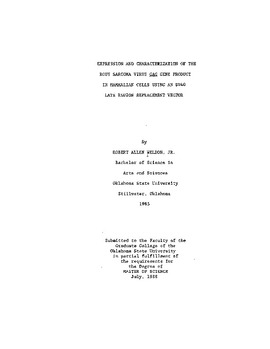| dc.contributor.advisor | Wills, John W. | |
| dc.contributor.author | Weldon, Robert Allen, Jr. | |
| dc.date.accessioned | 2015-08-19T16:06:52Z | |
| dc.date.available | 2015-08-19T16:06:52Z | |
| dc.date.issued | 1988-07-01 | |
| dc.identifier.uri | https://hdl.handle.net/11244/15741 | |
| dc.description.abstract | Classical retrovirology had its birth in 1908 with Peyton Rous studying spontaneous sarcomas (tumors of the connective tissue) in chickens. He found that the sarcomas were transmissible and that the tumors showed greater virulence with each passage. He tested cell free filtrates for the presence of the etiological agent, and for the first time demonstrated that the entity involved in the transmissible sarcomas was a virus (Rous, 1911). This virus now bears his name, Rous sarcoma virus. Since Rous's famous discovery of a filterable entity that could induce tumor formation in infected chickens, countless other viruses have also been discovered that induced a variety of neoplastic growths in the infected host. With the new sophisticated techniques of today we have been able to probe the molecular events that occur during a retroviral infection in hopes of elucidating how these viruses not only induce their neoplastic growth but also the molecular events that must occur to allow viral replication. At the time of this thesis, a major obstacle inhibiting detailed molecular studies of Rous sarcoma virus replication is the lack of adequate immortalized avian cell lines and expression vector systems. This thesis therefore is written in two parts. The first part addresses the block of RSV replication in mammalian cells. The idea was to devise a system to study retroviral assembly in immortalized cell lines. If we can elucidate the differences between the avian and murine retroviruses that allow iii the murine viruses but not the avian viruses to replicate in mammalian cells, we might be able to better understand the molecular requirements for viral replication and assembly. In order to study this block to replication of avian retroviruses in mammalian cells, I chose to use the simian virus 40 (SV40) as a vector to express the RSV gag gene (or the viral polyprotein Pr769a9 ) in mammalian cells. The second part of this thesis arose from a problem encountered while using the SV40 virus as an eukaryotic expression vector. The strategy for using this virus as an expression vector is quite simple. The sequence of choice to be expressed, gag, is cloned into the late region of the SV40 virus genome in place of the late genes. The expression of the foreign gene is then driven from the late SV40 promoter. This recombinant vector can then be propagated with the help of a second SV40 virus that supplies the late gene products in trans. The problem was encountered while trying to propagate the recombinant vector. We were able to successfully express Pr76 but unable to passage any newly assembled recombinant virions to fresh monolayers. Instead of then abandoning the project, I chose to pursue the problem in hopes of finding the molecular block in SV40 replication. This is important since finding a sequence or protein that inhibits SV40 replication might prove to be a valuable tool for elucidating the mechanisms of viral replication. | |
| dc.format | application/pdf | |
| dc.language | en_US | |
| dc.publisher | Oklahoma State University | |
| dc.rights | Copyright is held by the author who has granted the Oklahoma State University Library the non-exclusive right to share this material in its institutional repository. Contact Digital Library Services at lib-dls@okstate.edu or 405-744-9161 for the permission policy on the use, reproduction or distribution of this material. | |
| dc.title | Expression and Characterization of the Rous Sarcoma Virus Gag Gene Product in Mammalian Cells Using an Sv40 Late Region Replacement Vector | |
| dc.type | text | |
| dc.contributor.committeeMember | Melcher, Ulrich K. | |
| dc.contributor.committeeMember | Sandborn, Mark R. | |
| osu.filename | Thesis-1988-W445e.pdf | |
| osu.accesstype | Open Access | |
| dc.description.department | Microbiology | |
| dc.type.genre | Thesis | |
